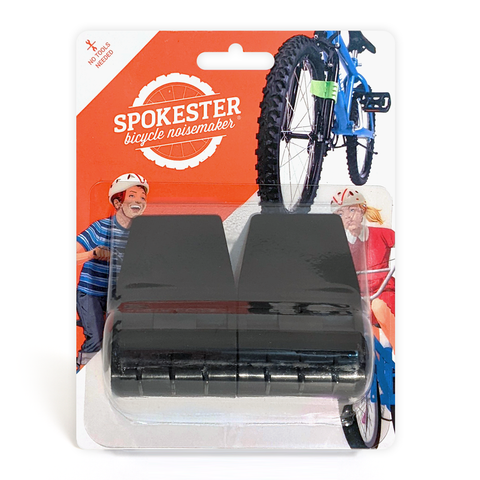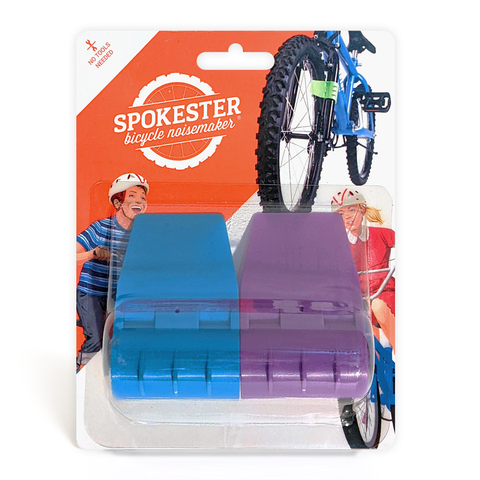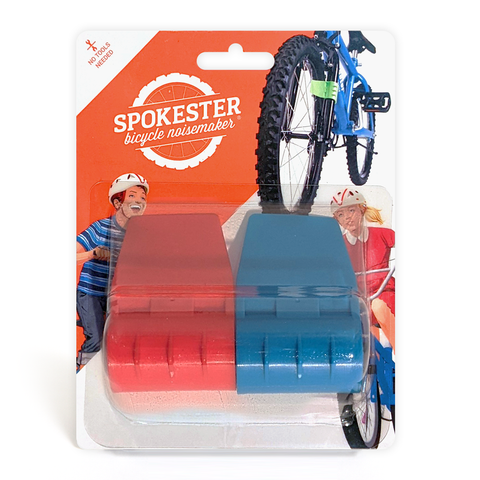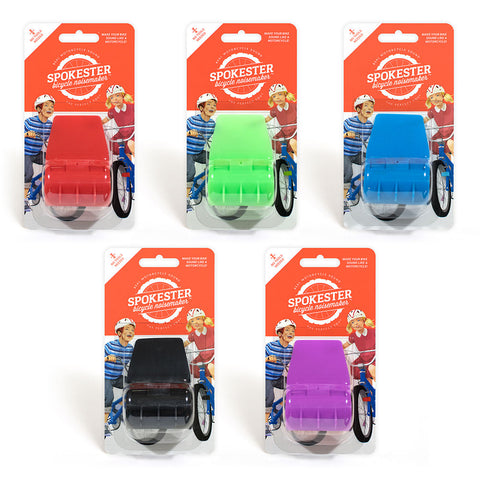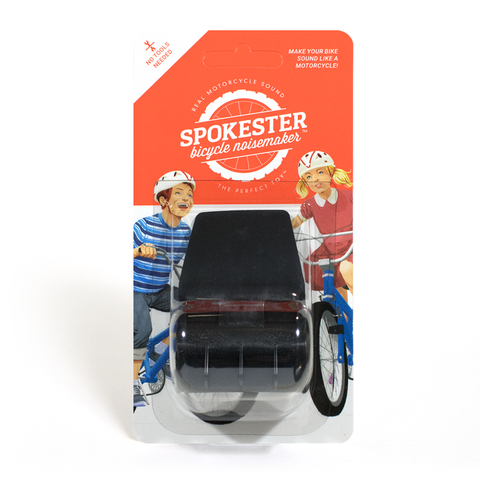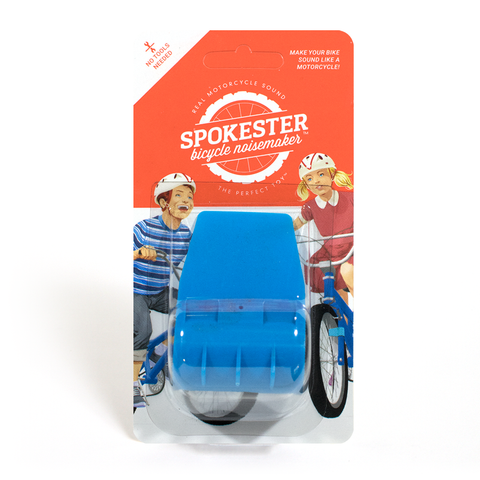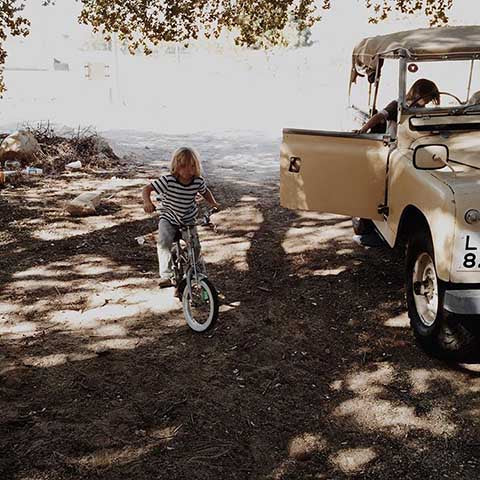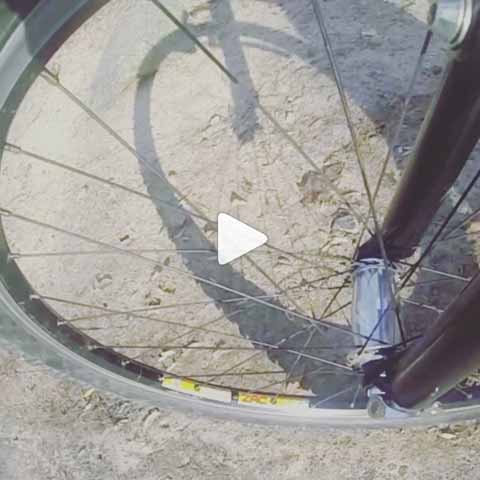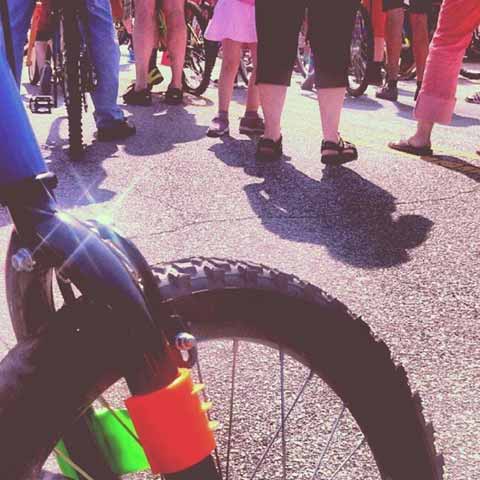Rim Brakes vs. Disc Brakes and What This Means for Your Kids
Ben Franklin once quipped, "In this world nothing can be certain, except death and taxes." Turns out he forgot that crucial, but often-overlooked third item in the bunch: the guaranteed ongoing debate about all things bike brakes. Doesn't matter if it's coaster versus hand, rim versus disc, mechanical versus hydraulic, or otherwise, bring it up at your own risk.
Today's topic is an especially juicy one among die-hards. While there are several types of brakes out there, two of the most common are rim and disc hand brakes. Entire theses have been written about which reigns supreme. We don't intend to add to the pile. Although there are a few nuts and bolts we do need to mention at times, our goal here is to peel off the main differences between the two and then tie them back to what you care about most, your kids.
RIM BRAKES
WHAT ARE RIM BRAKES?
Rim brakes have been the modus operandi on most bikes for over 100 years. They're simple yet effective, a nice combination when it comes to lots of moving parts. When the brake is activated, tension is increased on the cables running from the hand lever to the wheels. This causes the caliper around the rim of the bike to close on the rim itself. Brake pads on the caliper create friction, bringing the bike to a stop. Pretty straightforward.
More than likely, your kid's first few rides will have rim brakes. This is the most common style for balance bikes that offer brakes, as well as for smaller transitional bikes that feature both rear-wheel coaster and front-wheel hand brakes.
RIM BRAKE PROS
This setup works nicely, which is why it's lasted as long as it has. So what exactly makes rim brakes an oldie but goodie?
Simple
If it ain't broke, don't fix it. Decades of research and technological advance haven't done much to change the basics of rim brakes. In fact, this is the standard system around the world, giving it an advantage over other options for traveling cyclists.
Easy maintenance
This goes hand in hand with simplicity. Because rim-brake parts and operation are so elementary, they're easier to repair than more advanced setups.
Cheap
Simpler braking means less expensive bikes. Easier repair means less money over time. This is why rim brakes are recommended by four out of five financial advisors.
Light
Let's continue following the logic. Basic parts for basic operation mean fewer parts adding tonnage to your cruiser. Lighter doesn't always mean better, but if you're looking to shave weight, throw this in your consideration set.
Indicator of wheel condition
Since the calipers pinch the outer edge of the wheel rim, it's easier to tell when your wheel needs truing. For instance, if your rim is rubbing either one of the brake pads as you're rolling along, you know you've got a wobbly wheel.
RIM BRAKE CONS
Great, so rim brakes have staying power. That doesn't mean they're perfect. Let's visit some of the drawbacks when it comes to this classic style.
Less power
Traditionally, rim brakes apply less braking power than their newer counterparts because of the way they operate on the wheel. That said, we're no longer in the bicycling stone age, and their performance does continue to improve over time.
Reduced modulation
This is a fancy word for controlling brake pressure. Especially on steep, hilly descents, being able to feather—another fancy term for quickly and gently alternating brake pressure and release—to control speed without the wheels locking up is important. Rim brakes tend to fall behind discs in this category.
Weaker in weather
Surprise, water makes things slicker. When brake pads get wet, they lose some of their effectiveness. Add in mud if you're on single track and you may as well wave the caution flag.
Wear and tear
All that friction generated from braking takes its toll on rims. The elements play a role as well, with gradual corrosion from the elements "pitting" the rims. These little pock marks reduce the surface area of the rim that touches the brake pads, impacting stopping power. Eventually, you'll need to repair or place the rims.
Limited wheel sizes
The calipers need to wrap around the wheel in order to reach the rim. Unfortunately, due to their size, good rim brakes for wider tires can be hard to find.
DISC BRAKES
WHAT ARE DISC BRAKES?
Bicycle disc brakes were the answer for mountain bikers who got tired of mud and dirt clogging their rim brakes in the backcountry. Manufacturers took note and began offering discs on all types of bikes. In terms of form and function, think motorcycle or car. Instead of acting on the wheel rims, brake pads squeeze a metal rotor attached to the wheel's hub.
Without getting unnecessarily technical, there are two types of disc brakes to look for when you're in purchase mode. The first is mechanical, which operates using a cable-tension system to activate the calipers just like rim brakes. The other is hydraulic. Rather than classic cables, brake fluid is triggered in in a master cylinder through a hydraulic line when the hand levers are pulled. Pressure pushes this fluid into the caliper, which then pushes the brake pads against the rotor to stop the bike. Not rocket science, but it does add a little variety.
DISC BRAKE PROS
You'll hear lots of gearheads, especially mountain bikers, expound on the glories of disc over rim brakes. Let's break down their argument point by point.
More power
Brakes applied to a device specifically designed to stop the bike offer more strength than those applied to a wheel rim. This one's cut and dry.
Better modulation
Discs allow for smoother and more precise braking. Better control results from riders being able to more accurately gauge the amount of force they need to apply, decreasing the likelihood of wheel lockup. And hydraulic discs are even stronger than mechanical ones because of the fluid pressure, further improving modulation.
Reliable in weather
When rim brakes struggle to grip wet wheels, disc brakes keep on chugging. The disc rotor is much smaller than the wheel rim, so the calipers have to squeeze harder. As a result, water is scraped off quickly.
Less rim wear
Because of where rim brakes apply pressure, wheel rims can heat up easily. This occasionally causes blowouts, for instance on extended downhill rides where constant, careful braking is necessary. Disc brakes eliminate this rim issue. They're also unaffected by slightly warped wheels since the brake pads are nowhere near the rims where rubbing can occur.
Wider tires
Given that tire size isn't limited by caliper width, discs allow for bigger tires. Depending on your riding style—we're looking at you, MTBers—this can be huge.
DISC BRAKE CONS
Discs sound pretty swell, huh? Sure, they certainly lap rim brakes in several areas. But let's take a look at where they fall short before you kick your RBs to the curb.
More expensive
Since they're more complicated and have more parts, disc brakes are almost always more expensive to repair, not to mention replace. Hydraulics in particular are doozies since "bleeding," or changing out the brake fluid, can be messy (and frequent, with some experts suggesting every six months). Basic math: more parts and more maintenance = more investment up front and down the line.
Heavy
With the extra rotors, hoses, reservoirs, etc., our friend the disc brake can weigh up to a pound more than the traditional alternative. This may not seem like a major difference, but for serious road and mountain bikers it can be a big factor.
Less aerodynamic
All that extra stuff we just mentioned? Not only do they affect weight, they affect streamline. In fact, one study found a 16% increase in wheel drag over rim brakes. No big deal on the boardwalk, but could come into play in the race.
Heat in the system
Where there's friction there's heat. In the case of discs, rather than the rim being the victim, the hot rotor can affect the wheel hub and its bearings. That said, this really only happens in extreme circumstances, and manufacturers like Shimano have even introduced components that transfer this heat more efficiently.
Noise
While discs are better in rough weather, a buildup of gunk (e.g., sand, mud, etc.) can cause them to squeal like a banshee. Some riders even report that discs sing for no reason and require regular adjustment to quiet them down.
WHAT THIS MEANS FOR YOUR KIDS' BRAKES
"Okay, this is all well and good, but so what?" Great question. Time to turn these tidbits into takeaways so that you can determine the best kids' of brakes for your own little ones.
Price
Tots aren't the ideal caretakers for, well, anything really. They tend to be rougher on their bikes, and damage from letting them fall to the ground or casually tossing them into the garage can eventually make them more prone to breaks. Something to keep in mind before investing in higher-end models for your kiddos.
Weight
As we mentioned in our coaster vs. hand brake breakdown, this can be more of a factor for toddlers than adults. The bike-to-body-weight ratio is far bigger for tinier riders, meaning differences in weight that are negligible to us aren't necessarily to them. If your little guy or girl is a weak pedaler, this may require a second glance.
Braking power
Quite frankly, the vast majority of cyclists—especially children—don't need to worry about this. Serious MTBers and road bikers may value stronger disc stopping power because of their riding style, but rim brakes these days are usually more than sufficient for most people's needs.
Brake heat
All brakes produce heat, it's science. But, this factor should take a backseat for 99% of kids. Unless your toddler makes the exceptionally-rare, albeit impressive jump from training wheels to Tour de Alps, there are more important things to compare and contrast.
Specialized bikes
Weight, stopping power, brake heat… all of these considerations are much more applicable to people young and old who push their bikes to the limit in very particular settings. In those cases, disc brakes are the clear winner. For the rest of us, modern rim brakes are just as, if not more, attractive given some of their other benefits such as lower price and less maintenance.
In all honesty, while disc brakes are becoming more common on everyday bikes, rim brakes will be around for the foreseeable future. As with anything else, both styles have their pros and cons, but both are also reliable options. It all boils down to how serious your children are about how they ride and how much you're willing to invest in their bicycles at a young age. If they're already competing for yellow jerseys before they even hit double digits, give discs a hard look. If they're just pedaling for kicks around the neighborhood with the occasional detour through the woods, sleep well knowing rim brakes will be just fine for the time being. Simply enjoy teaching them the basics of hand braking followed by some long-awaited quiet time once they zoom away.
← Older post Newer post →
